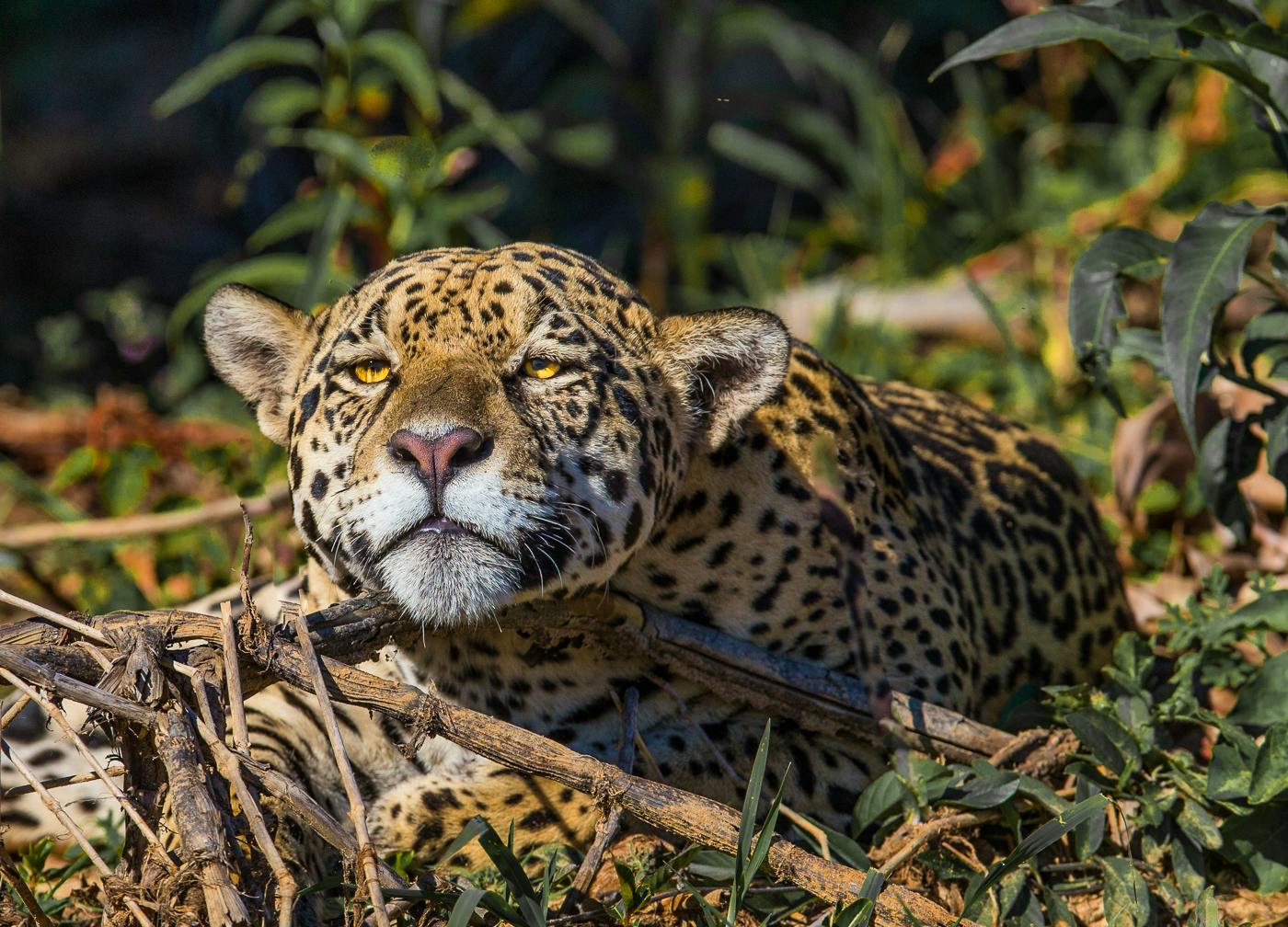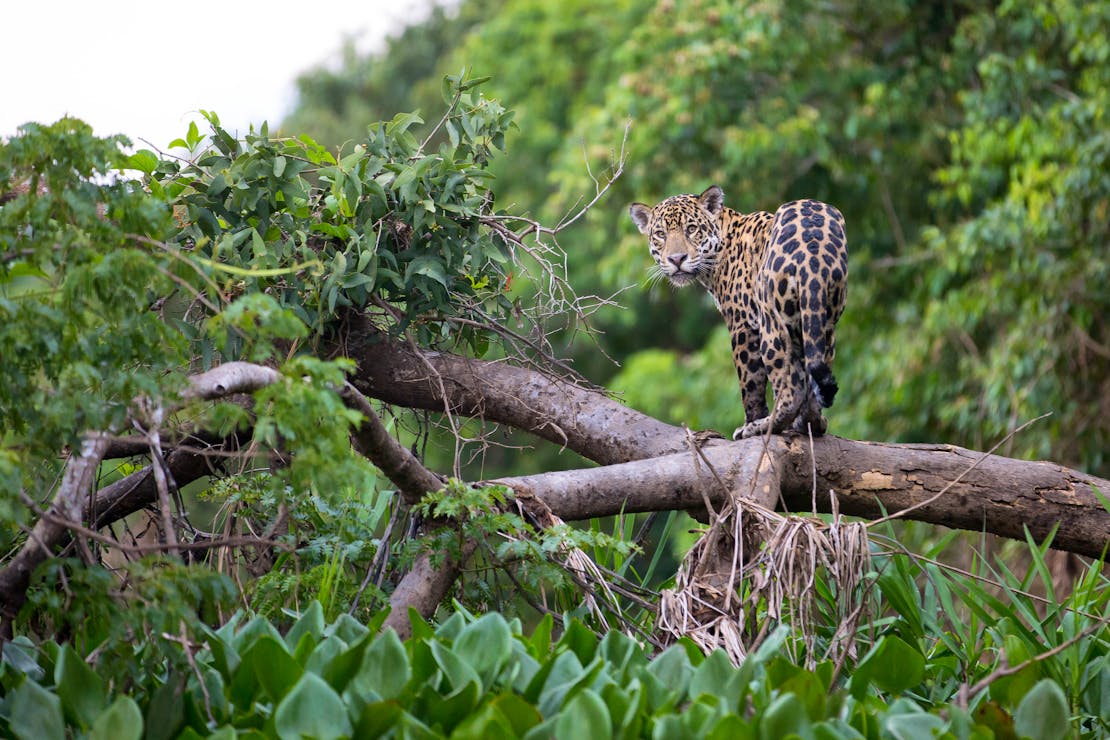Revered as warriors, deities, spirits and ancestors through the span of history, jaguars are the only big cats native to the Americas and have held a special place in indigenous cultures across their wide range. Referred to as "ghost cats" for their stealthy nature, jaguars are becoming increasingly rare as they are threatened by a number of challenges to their survival.
Read on to gain a better understanding of this iconic cat, including how big jaguars are, where jaguars live, what jaguars eat and why this legendary cat needs our help.
What is a jaguar?
Jaguars are the third largest cat in the world, behind tigers and lions. They can reach up to 300 pounds and 2.5 feet tall at the shoulder.
The name “jaguar” originates from the Tupi and Guarani languages of South America. Throughout history Jaguars have been the symbols of power for many cultures and are known by some as the protectors of the rainforests, where the largest known populations are found.
Jaguars are known by scientists today as sentinels of their ecosystems both in their roles as predators and as an umbrella species. As apex predators, their role in maintaining a balance in the food chain and species population is paramount to their ecosystem’s success. As an umbrella species, protecting jaguars also protects other species that share their habitat.
Where do jaguars live?
The range of the jaguar spans 19 countries, from the southwestern United States to northern Argentina. They are known to survive in diverse climates and have evolved to adapt to various habitats from arid forests and grasslands to lush tropical rainforests.
Jaguars residing in northern Mexico, Arizona and New Mexico primarily utilize woodlands habitat and river valleys. These forested high elevation environments, colloquially known as the “sky islands,” provide respite from the hot temperatures and arid conditions of the surrounding Sonoran Desert.
Leopard vs jaguar: How do you tell jaguars apart from other wild cats?
Jaguars are often mistaken for other spotted cats like leopards, cheetahs and ocelots. There are specific characteristics, however, that set jaguars apart.
1. Location: Jaguars are the only spotted big cat in the western hemisphere. Leopards are found in the eastern hemisphere in Africa, parts of the middle east and Asia. Cheetahs are also only found in the eastern hemisphere, primarily in Africa.
2. Pattern: Jaguar spots, known as rosettes, are often more open and feature a dot in the center. Leopards possess spots that are smaller and more closed in shape, without a center dot.
3. Build and Size: Jaguars have a stocky build and round head. They are significantly larger than ocelots and far more powerfully built than leopards and cheetahs.
What do jaguars eat?
Jaguars’ strong jaws, muscular build and ability to swim long distances makes them excellent hunters. They will often use ambush techniques and prefer to hunt at night. As strict carnivores, their diet includes anything from turtles and caimans to a number of smaller, land animals.
Jaguars are territorial and hunt by themselves except for mothers and their kittens. Young jaguars stay with their mother until they are about two years old. During these formative years, mothers teach their cubs how to hunt.
Are jaguars endangered?
Throughout their range, jaguar populations are decreasing due to a variety of threats. It is estimated these populations have declined by up to 25% over the past 30 years.
Jaguars are protected under the Endangered Species Act. They roamed throughout the southwestern U.S. for thousands of years, but they were driven to extinction in the U.S. by the mid-20th century due to predator elimination efforts and habitat loss. In the 1990s, these cats started to reappear in southernmost Arizona and New Mexico. Since that time, Defenders has worked at the forefront of the effort to conserve and restore jaguars in the U.S.-Mexico borderlands.
What is the greatest threat for jaguars?
The biggest threat to jaguars range-wide is habitat loss and fragmentation. Deforestation, agriculture, mining and human development have encroached on the vast areas the predators need to hunt.
The illegal wildlife trade has also had devastating impacts on the species’ stability. Jaguars were historically hunted for their skins. Today, the illegal trade of their bones and teeth continues. Hundreds of jaguars are believed to be killed each year for these international markets.
Helping jaguars
Help spread the word on this iconic cat! Read up on and support national and international policies to ban the trade of jaguars and their parts, and to protect their habitat. Now, more than ever, it’s critical for us to speak up for wildlife and spread factual information about the endangered species living alongside us. And, if you are able support organizations like Defenders that are fighting for jaguars and other endangered animals!











